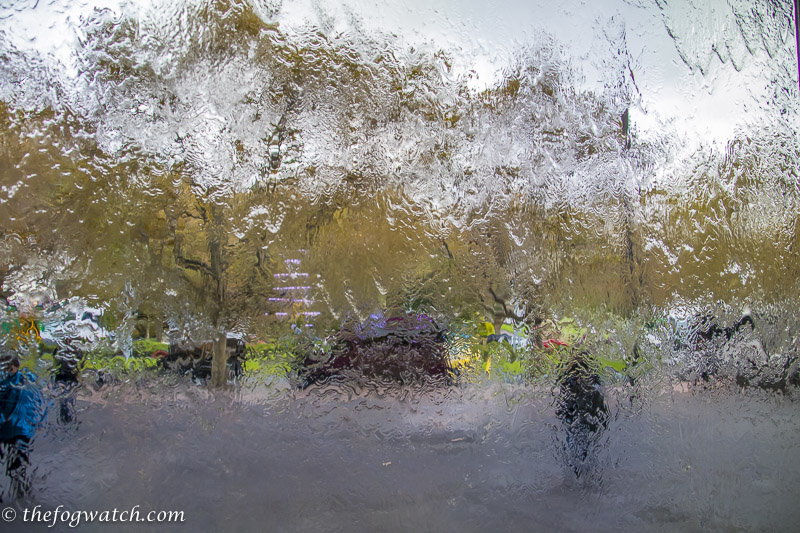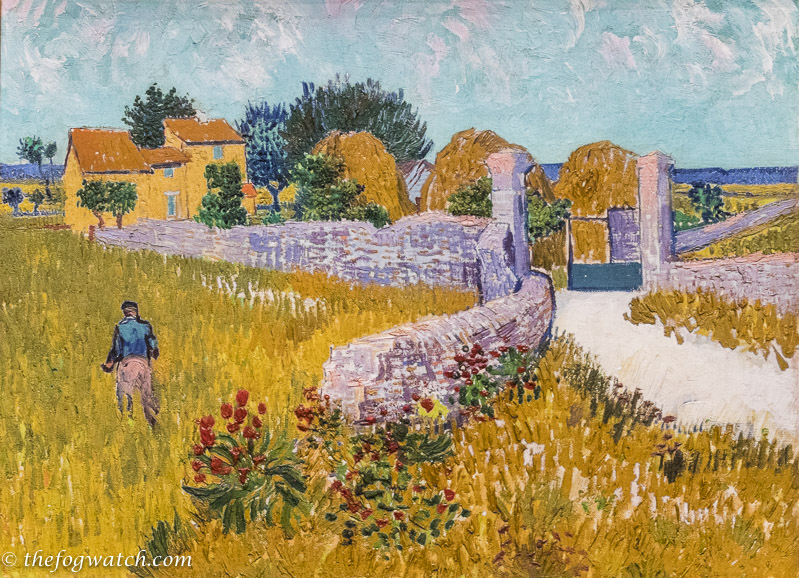The view through the water wall at the National Gallery of Victoria in Melbourne Australia is reminiscent of a Van Gogh painting. The light refracts in strange ways and distorts the image of the people and the traffic outside. I was here to see the exhibition: Van Gogh and the Seasons, so the image I captured as I entered the gallery was remarkably appropriate.

Life often seems to run in cycles or circles, just as the seasons return in sequence year after year. This exhibition links Van Gogh’s life’s work to the seasons. Nature was something of a preoccupation since the Romantic movement, and the exhibition begins with etchings and prints from other artists showing how they were representing the seasons, nature and farm workers. Then we encounter a series of Japanese prints which seem to be echoed in Van Gogh’s style where he painted with heavy outlines and filled in the forms.
Autumn/Fall
In October 1884, Van Gogh painted Avenue of Poplars in Autumn at Nuenen in the Netherlands. The sombre mood of the autumn trees is reflected by the lone woman walking the otherwise deserted road, dressed in mourning clothes. The shadows of the trees seem to reach for her as she seems about to cross a threshold marking her exit from the farm or village.
Vincent wrote to his brother Theo in June/July of that year describing his approach to painting the different light of the seasons:
“…I think Summer is not easy to express; generally, at least often, a summer effect is either impossible or ugly, at least I think so, but then, as opposition, there is twilight…
Spring is tender, green young corn and pink apple blossoms. Autumn is the contrast of the yellow leaves against violet tones. Winter is the snow with black silhouettes.”

His Autumn Landscape at Dusk painted a year later is more nuanced in his treatment of light. He wrote to his brother of his admiration for those who can paint darkness while observing that even in the lowest light there are still hints of things going on to maintain interest in the mystery:
“…it’s perhaps not superfluous to point out how one of the most beautiful things by the painters of this century has been the painting of darkness that is still colour.” – Van Gogh letters 21 Apr 1885
I found myself drawn into this painting, led by the path and the leading lines of the trees into the pool of orange and yellow that indicated the last fading light of sunset, following the footsteps of the woman returning to the village. I have learned a lot about photographic composition by noting the devices used by painters through the centuries. Here the horizon is placed about one-third from the bottom, and the path one-third from the left. The subject woman is backlit, providing an outline of her form which helps to draw us on in her direction.

These two paintings of Autumn – each with a path through the trees and a lone woman – illustrate that, on revisiting the subject, Van Gogh had developed further in his style, and produced arguably a stronger painting as a result. Here, in the second painting, he tantalises us with hints of things happening in the darkness – darkness that is still colour. And in Van Gogh’s life, even at his darkest hours, there was still some light, some colour.
But the cycles of life, like the seasons, never quite return the same. It is less a like a circle; more like a spiral. Some call this the hermeneutic spiral, in which we seem to return, yet we have moved on in our lives; we are older, we know more, we have more experience. It is one reason that people often return to a place they have travelled to, and in that return, the place is subtly different, or our approach to it is different. And we notice different things from the last time.
The Greek philosopher Heraclitus talks about this process when he says that we cannot step into the same river twice – time, like the waters of a river, moves on. Our experience of a place is altered by the very fact of seeing it again – we see it with fresh eyes.
Winter
The 1880s were a time of transition for art, and the growing fashion in the Netherlands – notably the Hague School – was focussed on outdoor painting and capturing a mood rather than bright colour. I loved the simplicity captured in this sketch of a woman digging in the snow. A few lines were sufficient to convey the back-breaking work and the stoic determination to maintain a meagre living in the depths of winter.

The sketch below is called: Sketch of miners in the snow: Winter and was one of a couple of “small rough sketches” he sent to Theo. It certainly didn’t look too rough to me!

Spring
I loved Van Gogh’s 1888 painting of the View of Saintes-Maries-de-la-Mer as it depicts a town quite similar to several towns we passed through on our Camino in Spain. The town here is about 50kms from Arles in the south of France – and in those days it was a five-hour horse coach ride to reach it. The town is in the Carmargue region, famous for its marshes and particular breed of horses. The town is on the Mediterranean. This visit served to cement his decision to stay in the south of France. I found the painting interesting for four reasons: Firstly, the bold use of monolithic blocks of colour – and the towns in that area actually do strike you like that. Secondly, the composition with the horizon on the Golden mean. Thirdly the cool-warm contrast between the rooflines and the sky and between the town and the blue-purple of the rows of flax plants and possibly grape vines in the foreground. Fourthly, I looked closely at the brush strokes and found that it appears that Van Gogh was left-handed – although there are no direct references to that, and Cezanne himself depicted Van Gogh with a brush in his right hand. But if you look closely at the brush strokes on the flax rows, they appear to be flicking up from right to left, rather than the other way round. I saw similar right-to-left markings in the way he cross-hatched his trees in other drawings.

Summer
In the summer of 1888, when Van Gogh had moved to Arles for one of his most productive periods, he painted a series on wheatfields and haystacks. This Farmhouse in Provence shows something of the intensity of light that he was able to capture. In this period he often mixed the colours straight on the canvas, giving the paint a vibrancy as the pigments are mostly unmixed, so they almost shine with their own light.

And yes the local stone actually does have a pinkish hue – it is a volcanic rock used in many of the local buildings in that area. I am constantly amazed by the accuracy of Van Gogh’s eye for light and for accurate drafting. In many cases you can go to the same spot and easily identify the same buildings today – I did a series of ‘then and now’ photos in Arles that I’ll discuss in a later post. Of the flowers, Van Gogh wrote:
“I know very well that not a single flower was drawn, that they’re just little licks of colour, red, yellow, orange, green. blue, violet, but the impression of those colours against one another is nonetheless there in the painting as it is in nature.” – letter Van Gogh to his sister Willemien 31 Jul 1888
One of the most striking paintings is A Wheatfield with Cypresses which contrasts the golden wheat with the deep green of the cypress trees – planted as a wind break against the strong dry Mistral wind that blows off the mountains – and then the blue of the distant hills. This one was painted in September 1889 at Saint-Remy, where Van Gogh stayed at the Saint-Paul de Mausole asylum. This painting, so full of life and vigour, was painted just a year before his suicide. Somehow, in the turbulence of the clouds and waving cypress trees he depicts something of the turbulence and violence of the Mistral wind and perhaps reflects something of the turbulence in his mind at that time.

So Van Gogh’s life, like our own can be seen like the cycle of the seasons. Travel too, can be seen in this light – and like Heraclitus says – we never truly return to the same place.
The same is also true of our return home after we have travelled. Suddenly, we see our own place in a new light, we notice new things about it, and perhaps question or seek to change things in light of our travel. There may be no place like home, but there is especially no place like home when we have informed our experience of it through mindful travel.
I travelled to Melbourne quite specifically to see this exhibition – and was not disappointed – even having seen the Van Gogh museum in Amsterdam and several of his works in the Musée d’Orsay in Paris. Many of the paintings displayed were from private collections and this would be one of the very few public showings. With around 60 works it is well worth seeing. The Van Gogh and the Seasons exhibition at the National Gallery of Victoria, runs until 9 July this year.
[NB: I was fortunate that since most of the paintings had come from French museums, hand-held non-commercial photography was permitted – so the photos I’ve included here are ones I’ve taken at the exhibition.]
________________________________________
Why not have these posts delivered to your in-box? Just enter your email address and click the ‘subscribe’ button in the left margin, and don’t forget to respond to the confirmation email in your in-box 🙂
________________________________________

The notes at the exhibition with the painting ‘A View of Sainte-Maries-de-la-Mer’ that the purple flowering plants are ‘wild flax flowers and possibly grape vines’. I agree they do look like lavender. I visited this wonderful exhibition last week and happened to take a photo of this painting and the notes alongside. Photos don’t do the painting justice. It is beautiful. I also like J the painting with the stone wall.
Thanks for your comment Jude – I’ve amended the post to reflect that information. It was an excellent exhibition 🙂
Wow this is an amazing summation of the exhibition. Beautiful writing. Thank you.
Thanks Nicole! I’m glad you enjoyed it – I certainly enjoyed and learned a lot from the exhibition 🙂
Thank you for giving me a glimpse of Van Gogh exhibition. I don’t get to the galleries any morep
Thanks Margaret – I enjoyed it so much I felt it was worth sharing 🙂